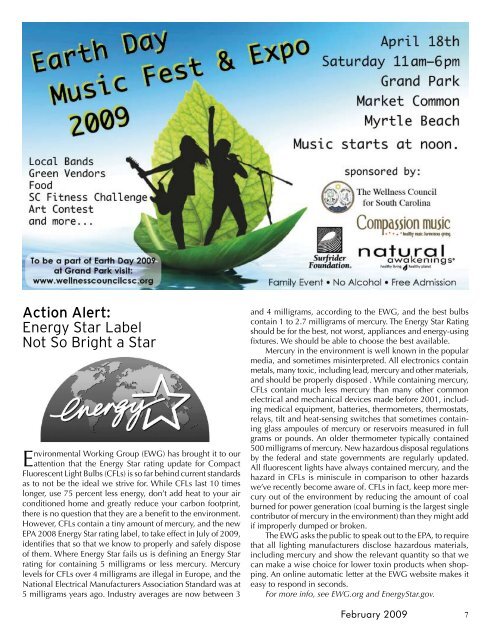soULmAtE - Columbia Natural AwakeningsâHome
soULmAtE - Columbia Natural AwakeningsâHome
soULmAtE - Columbia Natural AwakeningsâHome
You also want an ePaper? Increase the reach of your titles
YUMPU automatically turns print PDFs into web optimized ePapers that Google loves.
Action Alert:<br />
Energy Star Label<br />
Not So Bright a Star<br />
Environmental Working Group (EWG) has brought it to our<br />
attention that the Energy Star rating update for Compact<br />
Fluorescent Light Bulbs (CFLs) is so far behind current standards<br />
as to not be the ideal we strive for. While CFLs last 10 times<br />
longer, use 75 percent less energy, don’t add heat to your air<br />
conditioned home and greatly reduce your carbon footprint,<br />
there is no question that they are a benefit to the environment.<br />
However, CFLs contain a tiny amount of mercury, and the new<br />
EPA 2008 Energy Star rating label, to take effect in July of 2009,<br />
identifies that so that we know to properly and safely dispose<br />
of them. Where Energy Star fails us is defining an Energy Star<br />
rating for containing 5 milligrams or less mercury. Mercury<br />
levels for CFLs over 4 milligrams are illegal in Europe, and the<br />
National Electrical Manufacturers Association Standard was at<br />
5 milligrams years ago. Industry averages are now between 3<br />
and 4 milligrams, according to the EWG, and the best bulbs<br />
contain 1 to 2.7 milligrams of mercury. The Energy Star Rating<br />
should be for the best, not worst, appliances and energy-using<br />
fixtures. We should be able to choose the best available.<br />
Mercury in the environment is well known in the popular<br />
media, and sometimes misinterpreted. All electronics contain<br />
metals, many toxic, including lead, mercury and other materials,<br />
and should be properly disposed . While containing mercury,<br />
CFLs contain much less mercury than many other common<br />
electrical and mechanical devices made before 2001, including<br />
medical equipment, batteries, thermometers, thermostats,<br />
relays, tilt and heat-sensing switches that sometimes containing<br />
glass ampoules of mercury or reservoirs measured in full<br />
grams or pounds. An older thermometer typically contained<br />
500 milligrams of mercury. New hazardous disposal regulations<br />
by the federal and state governments are regularly updated.<br />
All fluorescent lights have always contained mercury, and the<br />
hazard in CFLs is miniscule in comparison to other hazards<br />
we’ve recently become aware of. CFLs in fact, keep more mercury<br />
out of the environment by reducing the amount of coal<br />
burned for power generation (coal burning is the largest single<br />
contributor of mercury in the environment) than they might add<br />
if improperly dumped or broken.<br />
The EWG asks the public to speak out to the EPA, to require<br />
that all lighting manufacturers disclose hazardous materials,<br />
including mercury and show the relevant quantity so that we<br />
can make a wise choice for lower toxin products when shopping.<br />
An online automatic letter at the EWG website makes it<br />
easy to respond in seconds.<br />
For more info, see EWG.org and EnergyStar.gov.<br />
February 2009<br />
7







